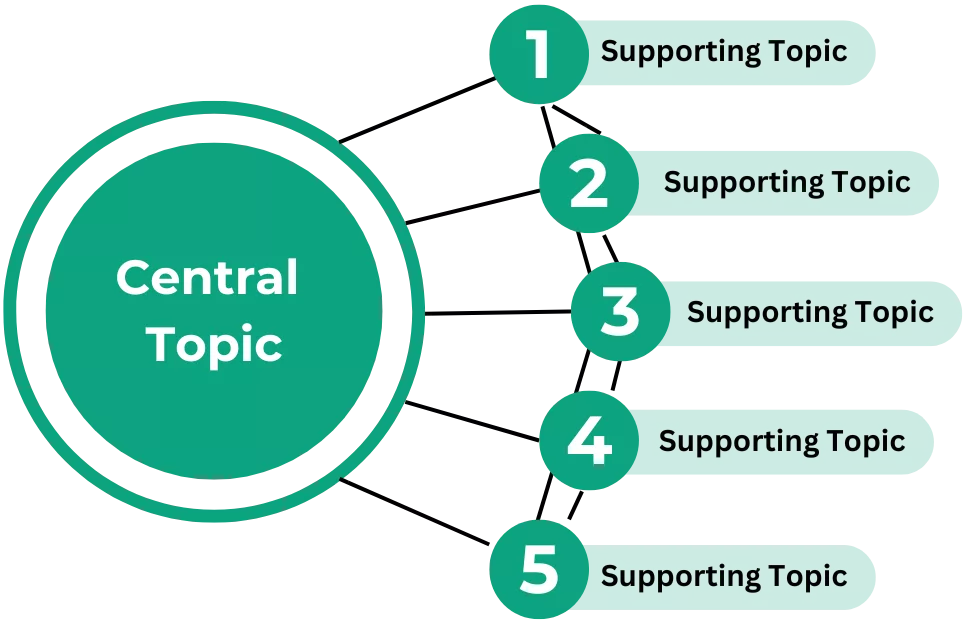At Write Ren, we often use the terms “content plan” and “topical map” interchangeably. That’s because content plan is the universally accepted term for the thing you produce when planning your future content.
However, our content plans are more than that. We map out how we’re going to capture topical authority.
What is Topical Authority?
Imagine you make a cheesecake that turns out all runny. Who do you turn to to ask for advice on how to make it better (other than Google)? Chances are, you know someone who’s a good cook. Because you know they’re a good cook–or a chef for a living–you probably repeatedly turn to that same person for a wide range of advice related to cooking.
Maybe you can’t even properly explain why, but you probably have a specific person you tend to turn to for advice about X, where X could be any general topic. Maybe Mae knows a lot about computers and Jerry knows a lot about gardening.
So you ask Mae which laptop to buy when yours gives up the ghost, and you ask Jerry why your tomatoes keep dying.
Google does exactly the same thing. They know who the authority on cooking is, so when that site writes an article on runny cheesecake, it instantly ranks among the top results.
And that’s our goal for you.
We want you to become that authority in your niche.
How Do We Achieve It?
Visually, here is what one branch of a content plan looks like:

Each green circle is a blog article or landing page optimized for a certain search term, and each of those black lines represents an internal link between them, so the various supporting topics will “prop up” the central topic as well as 2-3 other supporting topics.
There are 3 major steps in designing a topical map:
1) Pick your cornerstone or “central” topics.
2) Keyword research/map out your “supporting” topics.
3) Meet your customers “where they are”.
Cornerstone
This is the most obvious part of the process. These are the high volume, all-encompassing, pillar topics you want to become an authority in. These are often the names of your services, or the higher level generic names for your products. For a web designer, the obvious ones are things like “web design” and “SEO”. For someone who sells a wide range of clothing items, these might be “baby clothes” or “belts for men”.
Supporting Topics
The truth is, for most sites, there is very little chance you will rank for those cornerstone topics in a short period of time (sigh). Sorry, it’s just the truth.
So, we want to look for more specific (read: easier) topics to rank for that are related to the cornerstone topics and match the intent of someone searching for them.
One of our clients’ cornerstone keywords is “flashcards”. There is a lot of volume but also a lot of competition for this keyword, so we give them 5-9 easier keywords like “flashcards for learning to read”, which they can probably rank for in much less time.
With the cornerstone keyword in the center and 5-9 supporting keywords surrounding it, this becomes a single “topic cluster” (referred to as “branch” of a content plan earlier).
First, our clients’ sites will often rank for these “easier” keywords. Even a relatively new site can rank for “flashcards abc” if their article/page is well optimized, because the competition is very low.
On top of that, when your “flashcards abc” page starts ranking, it also links back to your “flashcards for learning to read” page/article and your “flashcards numbers” article, and of course, all of them link back to your central cornerstone “flashcards” article.
All of these pages lend credibility or “authority” to the wider topic of “flashcards”, thus giving your site “topical authority”.
We usually recommend you start this with 5-8 central topics, and depending on how related they are, they’ll usually lend authority between them as well.
This will give you 5-8 “branches” of your content plan that more or less function independently, but will all lend credibility to your site as a whole.
Meeting Your Customers Where They Are
We will usually create an entirely new content plan that focuses on meeting customers where they are.
What that means is you aren’t necessarily only targeting keywords that are directly related to your product or service, but rather, writing articles that give your target customer the info they need–and then working your product into it.
As an example, we have a client who sells NFC tags that you can put on your stuff. Essentially, a digital name tag, someone can scan an NFC tag with their phone to reveal contact information and help return something that’s lost.
As tempting as it is to target keywords like “NFC Tracker” and “what is NFC tagging” (what their competitors are optimizing for and yes, we did those as well), it was a lot easier and a lot more effective to target keywords like “healthiest dog food” and “cat-friendly places in NYC”.
Why?
Well, pet owners made up about 80% of this client’s customer base (people use the tags like digital dog tags), so we would “meet customers where they are”. How many pet owners are searching for “digital dog tags”? Our software says, it’s about 140/month. How many pet owners are searching for “healthiest dog food”? About 18,000/month.
And the people who are searching for “healthiest dog food” are naturally taking a thought-out and proactive/forward-thinking approach to raising their pets. The venn-diagram of people wanting their dogs to eat the healthiest food + people who might be interested in a better/safer dog tag is close to a full circle.



